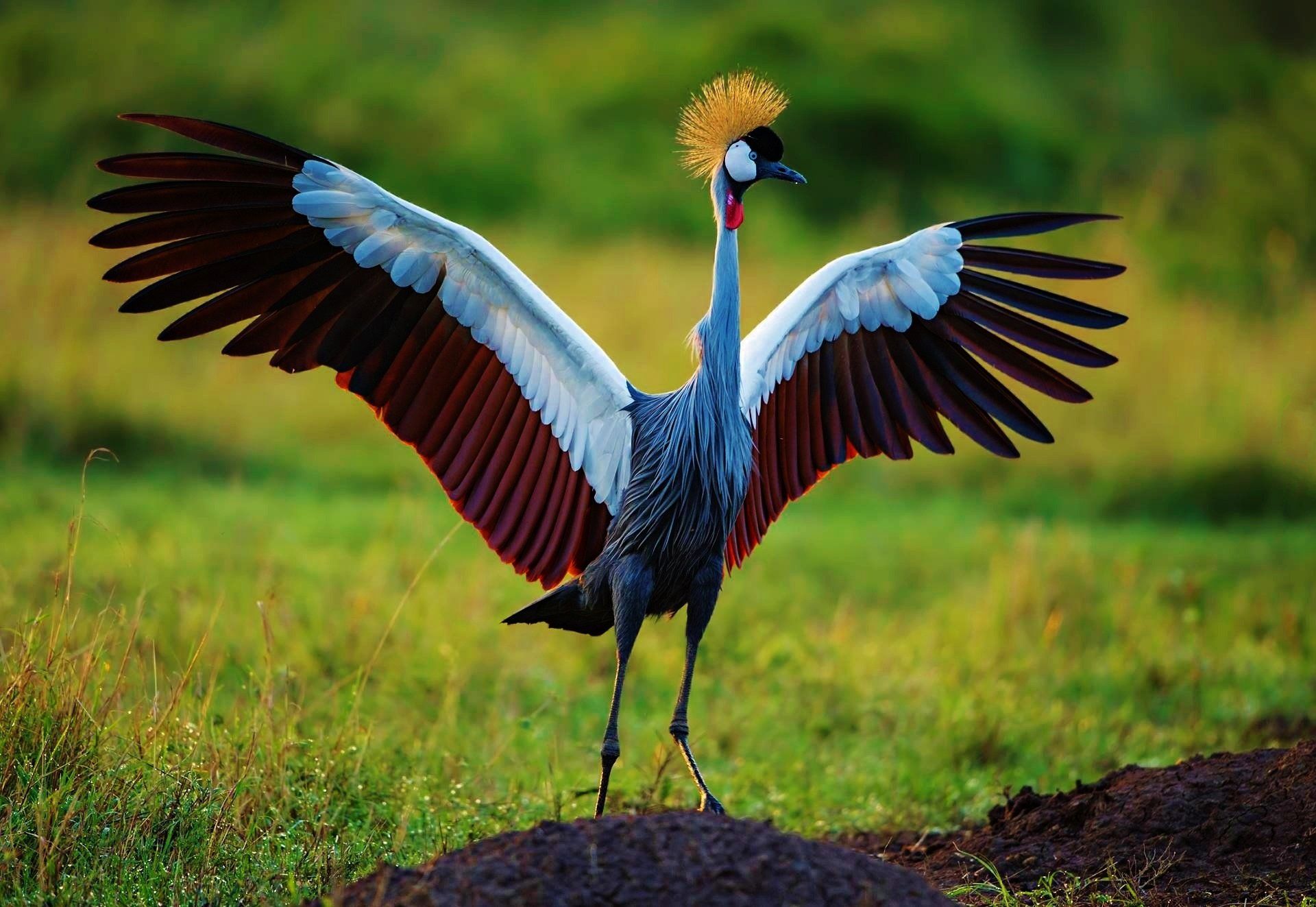
The Crested Crane
The Crested Crane (also known as the Grey Crowned Crane) is scientifically named Balearica regulorum. This elegant bird is distinguished by its vibrant color palette and fascinating way of life.
There are two subspecies of the Grey-crowned Crane. The first, B. r. gibbericeps, commonly referred to as the East African Crested Crane, is found in East Africa, particularly in Uganda, Kenya, and the eastern parts of the Democratic Republic of Congo. The second subspecies, B. r. regulorum, is known as the South African Crowned Crane and is primarily found in the southern regions of Angola and South Africa.
Uganda’s National Bird
As the national bird of Uganda, the grey crowned crane is highly respected and protected by law. Even young children know that it is a national symbol deserving of respect. In 1893, the then governor of Uganda, Sir Frederick Jackson, chose this bird as a symbol on the Union Jack. It was later approved by His Majesty King George V of England to be included on flags flown by the governor of Uganda. The crested crane remains Uganda’s national bird, admired for its beauty and graceful nature. It appears on all instruments of the state, including the national Coat of Arms.
Facts about the Crested Crane
Physical Look
The grey crowned crane is a tall bird that stands at an average of 3 feet tall. That is close to 1 meter in height. The crested crane weighs an average of 3.5 kilograms. The head of a crested crane has a velvet black forehead, a yellowish (almost golden) crown, red inflatable throat pouches and white sides. This is completed by a black and straight beak. It has a long greyish neck falling back to the same black, white, red and yellow colors over the rest of the body. The legs are long and slender meant to balance its body. It will most likely be the most colorful and fascinating bird you will be able to see on your birding trip to Uganda.

Natural Habitat
The crested crane is found only in parts of Eastern and Southern Africa. It typically lives in dry, open areas but prefers to nest in wet environments such as riverbanks and wetlands.
Food & Diet
The crested crane is an omnivorous animal, meaning it feeds on both plant and animal matter. Its diet includes leaves, seeds, grass, insects, worms, rats, flies, grasshoppers, small fish, and even snakes. In addition to this variety of foods, the crested crane prefers to eat the seeds of grasses and sedges. It spends the entire day searching for food and sleeps in trees at night.
Social Habits
The Crested crane is commonly known for its ‘dance’. This is when it spreads is majestic wings and flaps as it skips around. Not much of pattern but the wings spread to vividly reveal how beautiful the colors blend together. The top of the wings are black but the feathers are white.
This is most common in the breeding season although they can dance all year round. If you happen to see a number of them ‘doing the dance’ it is quite a spectacle.
When it is not walking around searching for food, the crested crane can rest or stand on one foot, while holding the other close to its body. It has a distinct way of communication that differentiates it from the Black-crowned cranes. When making a call, the crested crane sounds like a honking noise.
Socially, the crested crane is a monogamous creature, having one partner for all their lives. Although you might not be able to tell the difference, the male crested crane is always slightly larger than the female one. You might often see them in pairs if they are not feeding on the riverbanks. Flocks of 30 to 150 birds can be found around wetlands.
In Uganda, the Crested crane can breed and produce all year round, but this is most common in the dry seasons. The crane partners construct large nests using tall wetland grass and vegetation. The female lays 2 to 5 dirty-white eggs. Both partners take turns incubating them between 28 and 31 days. The young ones are called chicks.
The chicks of the crested crane can start running at the moment they hatch. A crested crane can live for an average of 22 years.
Conservation Status
The grey crowned crane is listed by the International Union for the Conservation of Nature (IUCN Redlist) as endangered. Recent studies indicate that the population of these birds keeps decreasing and they could soon become critically endangered.
Current global populations of the crested crane are thought to be at around 22,000 mature birds. This is much less than what Uganda had in the 1970s. In Uganda, the grey crowned cranes’ numbers have plummeted from 70,000 in the 1970s to less than 10,000 by 2011. The major reasons for the decreasing population are related to the shrinking natural habitat. As mentioned above, the crested cranes thrive well in areas near inland wetlands in Eastern and Southern Africa. Due to the rapid increase in population, wetlands have gone under a lot of pressure from human activity such as agriculture and urbanization. This has greatly reduced the natural habitat for the crested crane.
Thank you for choosing us!!


